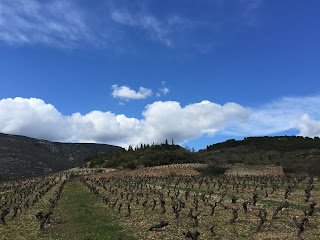When your vines were planted, how did they know how many vines to plant?
It’s all very much a balance of how many vines to plant according to soil type to ensure you get the right yield. Too high a yield can mean poor quality grapes but again it’s not that simple. Depending on the soil type you may get a higher yield from fewer vines if the soil is fertile but a lower yield from the same planting density if the soil is poor.
In the old days they would plant the vines in 1.5 m x 1.5 m squares resulting in 4,400 vines / ha. The vines were planted in squares so that the horse could criss-cross plough in both directions.
The distances were measured in 'pan', which is an old measurement used locally and is equivalent to 25cm. The vines were planted at 6 pans (1.5m) for horses then at 6.5 pans or 1.625 m for the first Chenillard tractors. Today vines are planted at 2m for the modern tractor.
It is difficult to give a general rule on planting densities and the effect on the quality of the wine as this also depends on the soil and how the vines are worked so you really have to know each individual vineyard intimately. As Jean Marc’s grandad used to say ‘A chaque terre, sa guerre’ - which loosely translated means each vineyard has its own problems.
 |
| My old Carignan and Grenache vines planted at 6 pans (1.5m) |
What are those larger passageways in the photo?
Often when we take over an old vineyard we take up one row of vines every 6 rows so that we can get the tractor in to help with vineyard management. This does lower the density of vines and if we didn't let the grass grow it would increase the yield and lower the quality on the vines growing along the passageway.
Are all your vineyards planted the same?
In the time of horses, to increase the density the vines were sometimes planted in a diamond shape rather than a square. This can be seen in our Macabeu vineyard above the village of Paziols. The distance between the rows is thus reduced to 1 m instead of 1.5m. This vineyard was planted about 80 years ago and as it is the bottom terrass, the soil is relatively fertile. The soil could cope with a higher density of vines so they planted in a diamond shape. This made the rows too narrow to even get a horse down so the vineyard was weeded by hand using a ‘bigos’ - a two pronged fork.
Yes, and we should add that at Domaine Jones we will not be planting any new vineyards. We will respect tradition and continue to be mollycoddle our exclusively old vines as they give us such fantastic quality wine! Even though they are nearly all gobelet style (bush vine) and back-breaking to prune!
 |
| A bigos - definitely not a modern day option for weeding our vineyards |
Is planting density the only factor that can affect the yield?
Planting density is not the only factor that will effect the quality and yield of the vine and at the moment we are thinning out the vines shoots to make sure that the yields are kept low.
Domaine Jones is very much focused on achieving low yields - and we can do this with the help of our old vines (average 80 years old) and our steep slopes with infertile soils (the roots of the vines have to work much harder to get their nutrients).
Ok so now we know about planting densities!


